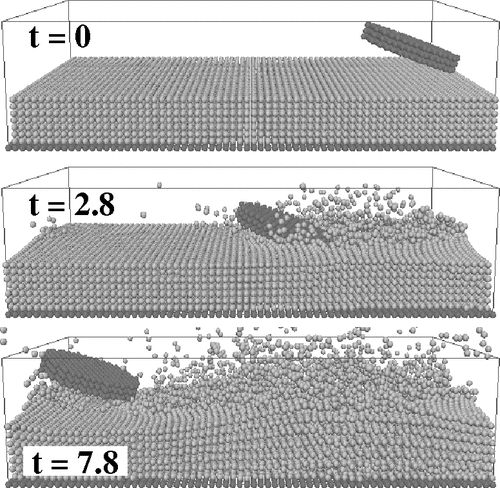细推物理须行乐 何用浮名绊此身
Search
-
Recent Posts
Random Posts
Tags
Links
//本文是我在知乎上的回答《如何学会打水漂》,后来很荣幸被推荐到了知乎日报《在强大的科学研究指导下,学会打水漂》。
一篇2004年的 Nature 文章[1]里介绍了打水漂的秘诀:神秘角度20°。这篇文章通过系统的实验发现,无论自旋角速度、抛射速度如何,石头与水面的攻角在20°时,石头与水面的接触时间都最少,而该接触时间决定了能量损耗的大小,接触时间越短能量损耗越少,因此20°角是打水漂的关键。注意这里攻角的定义是石头圆盘那个面与水面的夹角,不是入射速度方向与水面的夹角(此角度在15°~40°之间都对结果影响很小)。

后来一篇2005年的 PRL 文章[2]通过数值模拟重复出了同样的结论,并且给了理论解释。上图出自[2]。
石头的自旋角速度可以让石头的运动更加稳定,尽量维持攻角不变,其原理即陀螺仪的原理,角动量守恒[3]。因此自旋角速度越大越好。
石头的抛射速度代表了初始平动动能的大小,每次石头与水面碰撞一次将损失一定的能量,到最后能量太低时石头就落入水中了。文献[4]证明了如果水平速度可以维持不变的话,那么打水漂可以永远进行下去。因此抛射速度也是越大越好。
至于石头的形状,和经验一致,就是扁圆盘状最佳。
以上囊括了打水漂的所有要素:用扁圆盘状石头,攻角要尽量做到是20°,自旋角速度越大越好,抛射速度越大越好。祝你成功!
//以下是装逼的参考文献:
[1] http://www.nature.com/nature/journal/v427/n6969/full/427029a.html
[2] Phys. Rev. Lett. 94, 174501 (2005)
[3] The physics of stone skipping
[4] Continual skipping on water
[5] Stone skipping
physixfan
eaglefantasy
Eagle_Fantasy
宇宙的心弦
Traction Theme by The Theme Foundry
Copyright © 2025 physixfan. All rights reserved.  宇宙的心弦 by physixfan is licensed under a Creative Commons Attribution-NonCommercial-NoDerivatives 4.0 International License.
宇宙的心弦 by physixfan is licensed under a Creative Commons Attribution-NonCommercial-NoDerivatives 4.0 International License.
Necessary cookies are absolutely essential for the website to function properly. This category only includes cookies that ensures basic functionalities and security features of the website. These cookies do not store any personal information.
Any cookies that may not be particularly necessary for the website to function and is used specifically to collect user personal data via analytics, ads, other embedded contents are termed as non-necessary cookies. It is mandatory to procure user consent prior to running these cookies on your website.

我觉得学术派的世界好复杂。